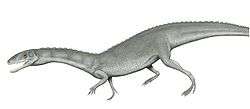Yerrapalli Formation
The Yerrapalli Formation is a Triassic rock formation consisting primarily of mudstones that outcrops in the Pranhita–Godavari Basin in southeastern India.[1] The Yerrapalli Formation preserves fossils of freshwater and terrestrial vertebrates as well as trace fossils of invertebrates. The tetrapod fauna includes temnospondyl amphibians, archosauromorph reptiles, and dicynodonts.[2]
Geology
Most of the Yerrapalli Formation consists of red mudstones. The mudstones were deposited across a floodplain during the Anisian stage of the Middle Triassic. Smaller lenses of calcareous sandstone represent ephemeral streams that branched off from the larger channels that were the source of the floodplain sediments.[2] The climate of the region during the time is thought to have been monsoonal with both wet and dry seasons.[3]
The Yerrapalli Formation overlies the Kamthi Formation, underlies the Bhimaram Formation, and is conformable with both formations. Two members of the Yerrapalli Formation have been recognized; a lower member consisting of layers of red and purple clay with lenses of pale green clay and an upper member consisting of alternating layers of clay and fine-grained sandstone.[3]
Paleobiota
The paleobiota of the Yerrapalli Formation is similar to that of the overlying Maleri Formation, which also preserves fossils of temnospondyls and archosauromorphs. The main difference between the Yerrapalli and the Maleri faunae is the presence of dicynodonts in the former. The discovery of dicynodont fossils in the Pranhita-Godavari Basin in 1964 was one of the earliest indications that the Yerrapalli Formation represented a distinct paleofauna. Before this discovery, Yerrapalli strata were grouped within the Maleri Formation.[3] The dicynodonts of the Yerrapalli Formation are similar to those of the Ntavere Formation in Zambia, which also dates back to the Anisian. During the Middle Triassic, what is now India and southern Africa formed one continuous landmass as part of the supercontinent Gondwana.
|
|
|
Color key
|
|
Notes
Uncertain or tentative taxa are in small text; crossed out taxa are discredited. |
Fishes
Amphibians
Reptiles
Synapsids
References
- ↑ Supriya Sengupta (1970). "Gondwana Sedimentation Around Bheemaram (Bhimaram), Pranhita-Godavari Valley, India". SEPM Journal of Sedimentary Research. doi:10.1306/74D71F0A-2B21-11D7-8648000102C1865D.
- 1 2 3 Sues, H.-D.; Fraser, N.C. (2010). "Early and early Middle Triassic in Gondwana". Triassic Life on Land: The Great Transition. New York: Columbia University Press. ISBN 9780231135221.
- 1 2 3 Bandyopadhyay, S. (1988). "A Kannemeyeriid Dicynodont from the Middle Triassic Yerrapalli Formation". Philosophical Transactions of the Royal Society B: Biological Sciences. 320 (1198): 185–120. doi:10.1098/rstb.1988.0072.
- 1 2 3 4 Jain, S.L. (1996). "Aspects of vertebrate fossils from Pranhita-Godavari Valley with emphasis on dinosaur discoveries" (PDF). Journal of the Palaeontological Society of India. 41: 1–16.
- ↑ Chatterjee, S. (1980). "The evolution of Rhyncosaurs". Mémoires de la Société Géologique de France. 139: 57–65.
- ↑ Sen, K. (2003). "Pamelaria dolichotrachela, a new prolacertid reptile from the Middle Triassic of India". Journal of Asian Earth Sciences. 21 (6): 663–681. doi:10.1016/S1367-9120(02)00110-4.
- ↑ Sen, K. (2005). "A new rauisuchian archosaur from the Middle Triassic of India". Palaeontology. 48: 185–196. doi:10.1111/j.1475-4983.2004.00438.x.
- 1 2 Chowdhury, T.R. (1970). "Two new dicynodonts from the Triassic Yerrapalli Formation of central India" (PDF). Palaeontology. 13 (1): 132–144.


